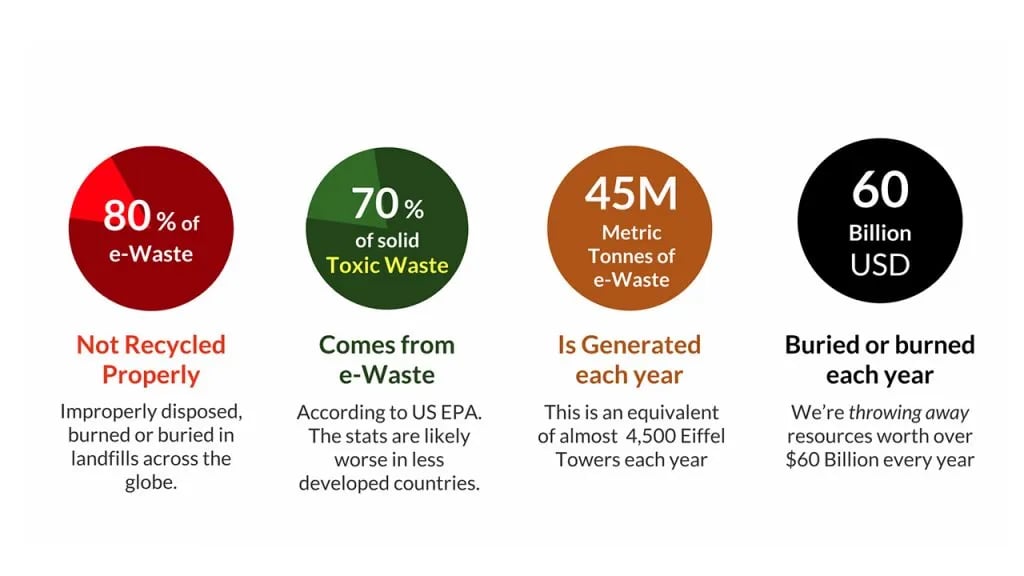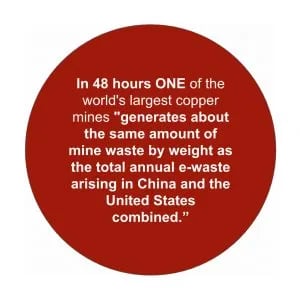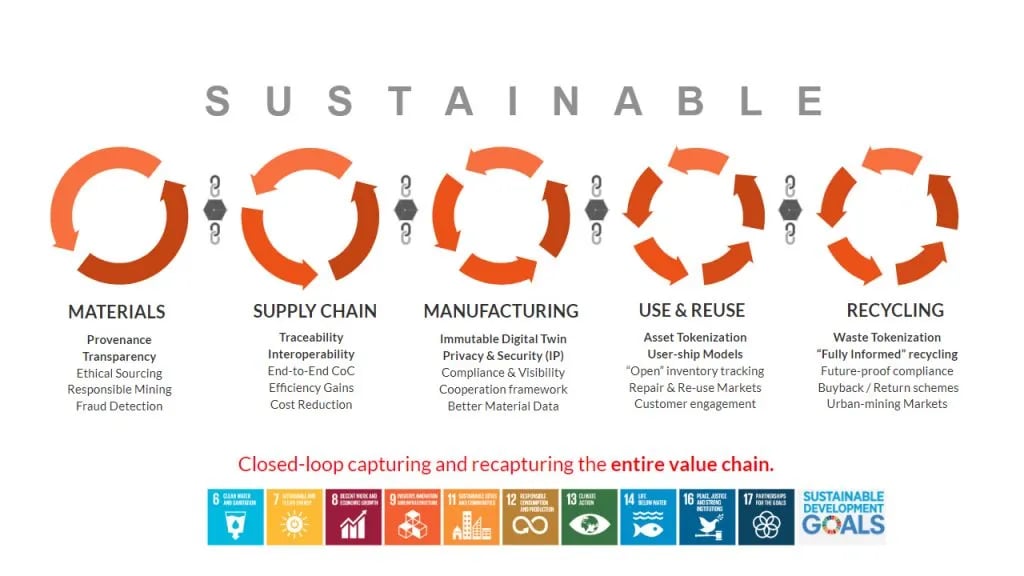It is hard to argue that industrialism didn’t improve the world.
Without industrial-scale production, affordable food, clothing, medicine, transportation and communication we take for granted wouldn’t be possible. However, the real costs of industrialisation, including enormous social and environmental impact, remain out of sight.
The real cost of technology
Technology is central in our day-to-day lives. By “voting” with our wallets, we’ve made Apple, Intel, Nvidia, Samsung into some of the world’s largest companies. But what happens when our devices become obsolete? And just how much resources are consumed, lives impacted, and waste generated, in making us shiny new ones?
Globally, over 45 million tonnes of e-waste is generated annually, with only 20% of this being recycled [1]. As a result, we collectively throw away resources worth US$60 billion annually [2]. E-waste accounted for 70% of solid toxic waste in landfills, according to US EPA3. Much of the e-waste ends up in low-income countries where retrieving precious metals from e-waste comes with huge health, environmental and social risks.

But dwarfing this is the amount of waste associated with mining these resources; in only 48 hours, just one of the world’s five largest copper mines generates about the same amount of mine waste by weight as the total annual e-waste in China and the United States combined [4].

Demand and subsequent disposal for large batteries – such as those found in electric vehicles and home power storage systems – is set to increase by 1000% within the next decade [5]; the demand for new smartphones, laptops and IoT devices is steadily growing as well.
In conjunction with the rapidly growing demand, there is a diminishing supply of scarce raw materials such as cobalt and lithium, as well as problematic 3TG minerals: tin, tungsten, tantalum and gold, sourced from virgin sources with conflict mineral6 and environmental concerns.
Conflict minerals have been linked with funding killings, violence, and other human rights abuses in the Democratic Republic of Congo and other conflict zones.
Regulatory, investor and consumer pressure
Social, health, safety and environmental regulations differ from country to country and continuously evolve. A company operating globally needs to comply globally, which pushes them to collect information, analyze it, act and report the outcomes.
Simultaneously, investors are putting pressure on brands to report on the impact of their operations. Sustainable investing is already a $12 trillion market in the U.S.7 and these investors reduce risk by demanding transparency.
Finally, in today’s connection economy underpinned by the social web, knowledge about the behaviour and impact of brands has started to influence consumer behaviour. The internet provides the same communication channels to everyone; NGOs, for example, can educate consumers on the impact of the electronics industry in very much the same way a brand can market their latest products, features and pricing.
To meet the demands of consumers, investors, and comply with regulations, brands are finally seeing the value in transparency in their supply chain.
Achieving transparency today starts with digitalization [8].
Making change happen
Electronics industry supply chains are global, complex and opaque. Manufacturers rely on declarations from their suppliers to gather information about raw materials in their end products. This process requires significant time and resources to compensate for fragmented “systems” around provenance, traceability, compliance and due diligence.
The cobalt and 3TG mineral supply chain typically involve ten or more organisations spread across two or more continents. Imagine how much combined effort involving communication, pressuring, audits, certifications, requests, responses, declarations, forms, standards, documents, emails, and phone calls does it take to implement even a small change, end to end, in such a fragmented ecosystem.
Blockchain technology can help eliminate these complexities [9] by enabling systems designed for end-to-end transparency.
Blockchain
Blockchain is a distributed network where many parties write to and read from a shared digital tamper-proof ledger, and transactions are both time-stamped and immutable. In such a system any deviations or abnormalities can be flagged quickly- making it possible to identify problematic points in the supply chain in almost real time.

This single truth without single source data architecture enables supply chain networks to share production & product data amongst all tiers [10] allowing them to jointly tackle their responsibilities and challenges at a fraction of the current cost.
With blockchain, participants may inspect the entire uninterrupted chain of custody from the raw materials to the sale of the finished product to end-users and beyond, all the way to end-of-life recycling stage.
End-to-end transparency and traceability make it a lot harder for unethical sources of Conflict Minerals and 3TG to enter the supply chain. It becomes much harder to “cheat” when everyone gets to check everyone else’s claims, all the time. By reducing information asymmetries blockchain can help supply chains more evenly spread the cost of impact [11], incentivising better social and environmental practices.
One such initiative is SustainBlock (www.sustainblock.org), which utilises blockchain technology to combine traceability and provenance with Due Diligence in the same solution. The project focuses on minerals sourced in Conflict Affected and High-Risk Areas (CAHRAs) with support from the European Partnership for Responsible Minerals (EPRM) whose members include Apple, Samsung, Intel and Fairphone, amongst others.
Trusted verifiable information about raw materials can enable more subjective consumer value perceptions [11], making ethically sourced cobalt, for example, worth more than cobalt of unknown origin. De-commoditisation is already taking place in the food sector where “ethical” and “sustainable” products sell at a premium. The same is possible for electronics.
To become truly efficient, the supply chain must shift towards becoming circular. An electric vehicle battery made entirely of recycled materials demonstrates manufacturers’ technological superiority and their commitment to sustainability. The challenge is how to verify and prove this continuously. The solution is likely a system underpinned by blockchain technology.
New tools and a new mindset
Across all sectors, unsurprisingly, organisations are investing in blockchain [12] predominantly to automate, de-risk and improve the speed, efficiency and costs in the supply chain.
But blockchain offers a much deeper integration as it enables the supply chain to connect the price, value and impact, from the start of the product journey to its end-of-life, and back again. Built-in transparency can help eliminate conflict mineral trade as well as enable accounting for social and environmental cost of our collective manufacturing and resource consumption choices. This will also encourage manufacturers to design products that don’t leave lasting negative social and environmental impacts for generations to come.

All we must do is apply blockchain technology with a circular mindset; focusing on achieving needs but prioritising efficiency and energy savings, including designing out waste, fraud, corruption and negative health, safety and environmental impacts.
Like the circular economy, blockchain solutions require collaborative design thinking.
First published on https://ewastewatch.com.au/
References:
[1] ‘Electronic waste poses ‘growing risk’ to environment, human health, UN report warns’, UN News, 13/12/17; https://news.un.org/en/story/2017/12/639312-electronic-waste-poses-growing-risk-environment-human-health-un-report-warns[2] Baldé, C.P., Forti V., Gray, V., Kuehr, R., Stegmann,P. : The Global E-waste Monitor – 2017, United Nations University (UNU), International Telecommunication Union (ITU) & International Solid Waste Association (ISWA), Bonn/Geneva/Vienna.; http://ewastemonitor.info/
[3] ‘One Person’s Trash Is Another’s Technology: Recycling or Donating Discarded Electronic Equipment Help Reduce E-Waste Pollution’, Scientific American, https://www.scientificamerican.com/article/earth-talk-recycling-e-equipment/
[4] ‘Almost everything you know about e-waste is wrong’, Josh Lepawsky; Https://theconversation.com/almost-everything-you-know-about-e-waste-is-wrong-93904
[5] Bloomberg NEF, Electric-Car Revolution Shakes Up the Biggest Metals Markets, August 3, 2017 https://about.bnef.com/blog/electric-car-revolution-is-shaking-up-the-biggest-metals-markets/
[6] ‘Conflict Minerals Regulation Explained’ EU Commission; http://ec.europa.eu/trade/policy/in-focus/conflict-minerals-regulation/regulation-explained/
[7] US SIF Foundation 2018 biennial Report on US Sustainable, Responsible and Impact Investing Trends https://www.ussif.org/files/US%20SIF%20Trends%20Report%202018%20Release.pdf
[8] Envisioning a sustainable future: increasing resource efficiency through digitization’; Martina Prox, ifu Hamburg / iPoint Group https://www.ipoint-systems.com/blog/envisioning-a-sustainable-future-increasing-resource-efficiency-through-digitalization/
[9] ‘RMI’s Blockchain Guidelines’ ; Responsible Minerals Initiative, http://www.responsiblemineralsinitiative.org/emerging-risks/blockchain/
[10] ‘A little supply chain disruption thought exercise’; Oliver Beige https://medium.com/@trialsanderrors/a-little-supply-chain-disruption-thought-exercise-64f4a705537a
[11] Darcy W. E. Allen, Alastair Berg, Brendan Markey-Towler: RMIT University Blockchain Innovation Hub -Blockchain and Supply Chains: V-form Organisations, Value Redistributions, De-commoditisation and Quality Proxies https://jbba.scholasticahq.com/article/7556-blockchain-and-supply-chains-v-form-organisations-value-redistributions-de-commoditisation-and-quality-proxies
[12] ‘Big Blockchain: The 50 Largest Public Companies Exploring Blockchain’; Michael del Castillo https://www.forbes.com/sites/michaeldelcastillo/2018/07/03/big-blockchain-the-50-largest-public-companies-exploring-blockchain/#5841e1c22b5b





